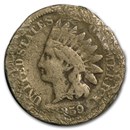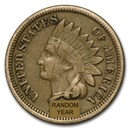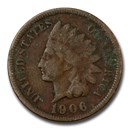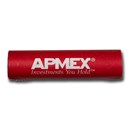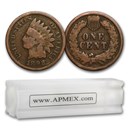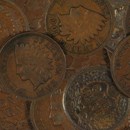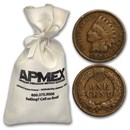Indian Head Pennies (1859-1909)

| Quantity | Check/Wire |
|---|---|
| 1 - 49 | $2.29 |
| 50 - 99 | $2.09 |
| 100 + | $1.89 |


| Grade | Mintage | Population |
|---|---|---|
| 13,740,000 | 261 |


| Grade | Mintage | Population |
|---|---|---|
| 13,740,000 | 671 |
Indian Head Pennies
The second of the U.S. “small cents,” the Indian Head is one of the most popular U.S. coins ever struck. The obverse features Liberty wearing a feathered headdress, while the reverse depicts a wreath encircling the words “one cent.”
The Indian Head Penny, also known as the Indian Head Cent, holds a special place in American numismatic history. Introduced in 1859, it featured a new and distinct design that depicted Lady Liberty wearing a Native American headdress on the obverse and a wreath on the reverse. The Indian Head Penny was a departure from its predecessor, the Flying Eagle Cent, and aimed to capture the spirit of American expansion and the cultural diversity of the nation.
Designed by James B. Longacre, the Indian Head Penny reflected the artistic trends of the mid-19th century. The obverse showcased a proud and stylized representation of Lady Liberty, while the reverse featured an intricately detailed wreath composed of agricultural products like wheat, corn, and cotton, symbolizing the agricultural heritage of the United States.
The Indian Head Penny underwent several modifications throughout its history. From 1859 to 1864, the coins were composed of a copper-nickel alloy, commonly known as "nickel cents." However, due to rising metal costs during the Civil War, the composition changed in 1864 to bronze, with the addition of tin and zinc. This change was necessitated to ensure the availability of copper for the war effort.
The Indian Head Penny witnessed various design changes as well. In 1860, the designer's initial "L" was added to the ribbon on the obverse, signifying Longacre's contribution to the coin's creation. Furthermore, in 1864, to distinguish the Indian Head Penny from counterfeit coins, the motto "In God We Trust" was included on the reverse.
The Indian Head Penny remained in production until 1909, making it one of the longest-running series of U.S. coins. Over its 50-year span, the coin bore witness to significant historical events such as the American Civil War, the westward expansion, and the Industrial Revolution. Its rich history and intriguing design have made it a favorite among collectors, offering a glimpse into the evolving cultural and artistic landscape of the United States during the 19th and early 20th centuries.
Today, Indian Head Pennies are highly sought after by coin collectors, history enthusiasts, and those captivated by the beauty and significance of these iconic coins. Their scarcity, historical context, and artistic appeal make them cherished collectibles.
Whether seeking to complete a collection, delve into the history of the United States, or appreciate the exquisite craftsmanship of the era, Indian Head Pennies continue to captivate and inspire collectors worldwide. Discover the value of U.S. Mint coins like common date Indian Head Pennies and learn more about the coins in your collection.
Collect Indian Head Pennies
For collectors, part of the value of the Indian Penny lies in the years in which it was minted. Due to its introduction just prior to the outbreak of the Civil War, this coin is often thought of as a tangible part of American history. For this reason, you may note that many of the coins produced through the first few years of the Indian Head’s existence are particularly valuable and desirable.
Over time, the value of Indian Head pennies may increase based on variables including availability and condition. For example, in the postwar period, the cent became very popular and was struck in large numbers, except in 1877, when a poor economy and a greatly lowered demand for pennies naturally created one of the rarest dates in the series. Condition also affects value; there can be a difference of hundreds of dollars in value between a worn coin and a very fine one.
Key Dates
Designed by James B. Longacre, Indian Head Cents have six key dates that that are notable to collectors. While the series began production in 1859, the first variety to be considered key today is the 1864-L. The “L” mintmark on this coin refers to the designer’s last name, rather than the production location. Other important dates for the Indian Head Cents series include 1869, 1872, and 1877. While millions of coins were produced during these years, examples in Very Fine condition or higher are incredibly rare. After the turn of the 20th Century, the 1908-S struck from 95 percent Copper is the first date to be thought of as key by numismatists. Coins made by the San Francisco Mint in 1909 are also valuable to collectors. Indian Head Penny key dates include:
- 1864-L
- 1969
- 1872
- 1877
- 1908-S
- 1909-S

